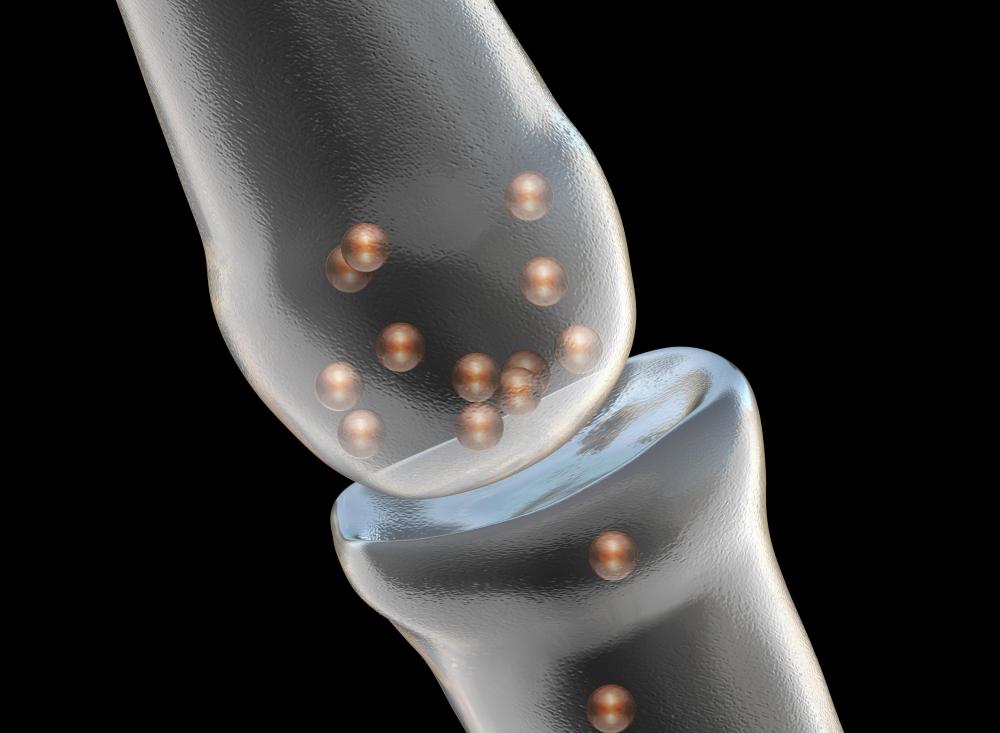At TheHealthBoard, we're committed to delivering accurate, trustworthy information. Our expert-authored content is rigorously fact-checked and sourced from credible authorities. Discover how we uphold the highest standards in providing you with reliable knowledge.
What Are the Different Types of Dendrites?
Dendrites are one of three parts that make up most nerve cells, or neurons. Almost all neurons have a similar structure that contains one axon; one cell body, also called the soma; and many dendrites. While every neuron has an axon and cell body, it may or may not have dendrites. When they are present, they can be found in one of two forms, which are apical or basilar.
No matter the type of dendrite, the function is the same. The surface is where nerve impulses are received from the terminal ends of the axons of other neurons. Nerve impulses are transmitted or inhibited at a synapse by means of chemical stimulation through the release of neurotransmitters. Usually, this impulse is then transmitted directly to the cell body or along the axon to a centrally located cell body, based on the type of nerve cell.

The two types of dendrites differ in a few fundamental ways. A basilar dendrite does not have a stalk like that seen on an apical dendrite. In most cases, basilar dendrites are found in greater numbers than apical ones. Another difference is that apical dendrites are mostly found within the cerebral cortex of the brain.
Apical dendrites can be further subdivided into two more groups, distal and proximal. Those in the distal group are longer and project from the cell body at the opposite end of the axon. Due to their length, they are said to form non-local synapses, which are not close to the nerve cell. An apical dendrite that belongs to the proximal group is much shorter and receives impulses from other neurons that are much closer, including interneurons.

Another method of classifying dendrites is by whether they are spiny or smooth. These categories are based on the presence or absence of dendritic spines. Smooth ones do not, and the nerve impulse is received directly on the shaft. Spiny ones do have dendritic spines, so the nerve impulse is received along the shaft as well as along the spines that protrude from it.
Smooth and spiny dendrites often carry different types of messages to the nerve cell. In most cases, the synapses found at a smooth dendrite are inhibitory, which means that the neurotransmitter that is released will inhibit, or reduce, the chance of the impulse being transmitted along the neuron. The synapses found at spiny dendrites are usually excitatory. This means that the opposite action occurs here, so the neurotransmitter will stimulate the impulse to continue along the neuron.
AS FEATURED ON:
AS FEATURED ON:












Discussion Comments
I think all neutrons have dendrites average of 1000 each. What would be the purpose of a neuron without dendrites? No means of transmitting anything. Like having an old fashioned wired phone without any wires.
Apical dendrites are very interesting. I've read that those who have more apical dendrites tend to have better memory. And lo of dendrites has been linked with conditions like Alzheimer's disease. The good news is that we can encourage their growth by doing things like playing chess, painting or playing a musical instrument. I plan on taking one up soon.
@bluedolphin-- I'm not an expert on this topic but I think that dendrites are found in the spine as well.
It's not surprising that dendrites would be found outside of the brain though. We have nerve cells all over our body. They are responsible for the communication that takes place between the various organs and the cells. For example, when we touch something hot and burn ourselves, the reason we feel pain and pull away is also due to the work of these nerve cells. They are the ones communicating the pain to our brain and then the brain takes action by pulling our hand away.
Of course, dendrites don't grow in every area where there are nerve cells. There are different factors that cause their growth. I don't know enough about it to explain though. Is there anyone here who can answer this more accurately?
Okay so apical dendrites are mostly in the cerebral cortex of the brain. Where else are dendrites found in the body? Are they all in the brain?
Post your comments